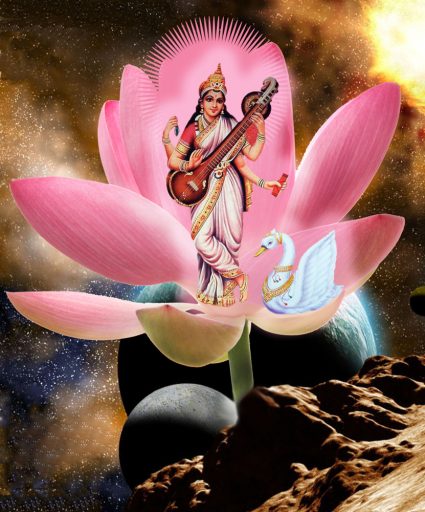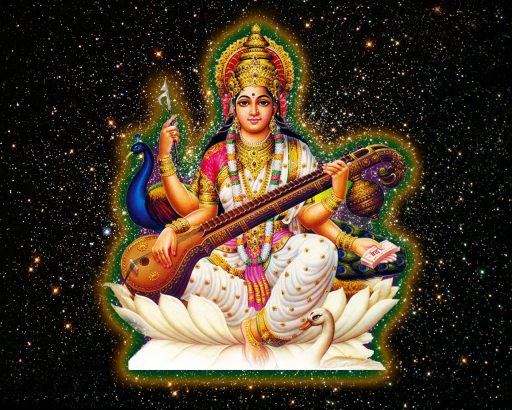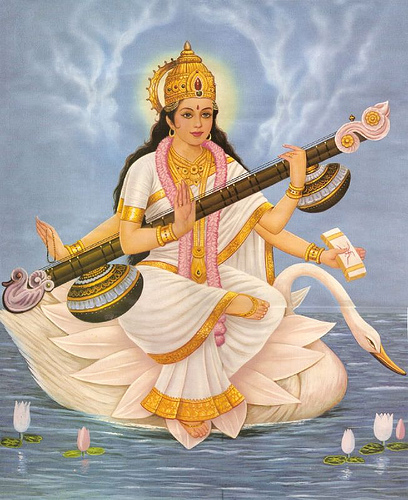
Saraswati Maa
Maa Saraswati or Devi Sarasvati is the goddess of knowledge, music and the arts. She is the consort of Lord Brahma. Goddess Saraswati is considered to be the “mother of the Vedas”
The name Saraswati came from “saras” (meaning “flow”) and “wati” (meaning “a woman”). So, Maa Saraswati is symbol of knowledge; its flow (or growth) is like a river and knowledge is supremely alluring, like a beautiful woman.
In the Rigveda, Saraswati is a river as well as its personification as a goddess. In the post-Vedic age, she began to lose her status as a river goddess and became increasingly associated with literature, arts, music, etc. In Hinduism, Saraswati represents intelligence, consciousness, cosmic knowledge, creativity, education, enlightenment, music, the arts, and power. Hindus worship her not only for “secular knowledge”, but for “divine knowledge” essential to achieve moksha.
In some Puranas (like Skanda Purana) she is sister of Shiva (Shivaanujaa) and in some Tantras with Ganesha. The original (spiritual) forms of devas including Saraswati are present in the spiritual world. In the center reside the deities of fire, sun and moon, Kurma-avatara, Ananta Sesha, and Garuda, the master of the three Vedas. The Vedic hymns and all sacred mantras also stay in that holy place, which is made of all the Vedas, and which is known in the Smriti-sastra [Scriptures of Remembrance] as the yoga-pitha [Sanctuary of Union]. (Padma Purana Uttara-khanda)
Accompanied by Godess Lakshmi and other associates, the chatur-vyuha (Four Expansions) headed by Lord Vasudeva are manifest in the eight directions, beginning with the east. In the directions beginning with the southeast, the palaces of Lakshmi, Saraswati, Rati, and Kanti respectively are situated.
According to Vedanta she is considered to be the feminine energy and knowledge aspect (Shakti) of Brahman, as one of many aspects of Adi Shakti as Maha Sarasvati.
In the Devi Mahatmya, Saraswati is in the trinity of Maha Kali, Maha Lakshmi and Maha Saraswati. She is depicted as eight-armed. Her dhyāna shloka given at the beginning of the Fifth chapter of Devi Mahatmya is:
Wielding in her lotus-hands the bell, trident, plough-share, conch, pestle, discus, bow, and arrow, her lustre is like that of a moon shining in the autumn sky. She is born from the body of Gowri and is the sustaining base of the three worlds. That Mahasaraswati I worship here who destroyed Sumbha and other asuras.

Maa MahaSaraswati Goddess of Wisdom
Maa Saraswathi is generally shown to have four arms, which represent the four aspects of human personality in learning: mind, intellect, alertness, and ego. Alternatively, these four arms also represent the 4 Vedas, the primary sacred books for Hindus. The Vedas, in turn, represent the 3 forms of literature:
* Poetry — the Rigveda contains hymns, representing poetry
* Prose — Yajurveda contains prose
* Music — Samaveda represents music.
The four hands also depict this thus — prose is represented by the book in one hand, poetry by the garland of crystal, music by the veena (Lute). The pot of sacred water represents purity in all of these three, or their power to purify human thought.

Goddess Devi Sarasvati
She is shown to hold the following in her hands:
* A book, which is the sacred Vedas, representing the universal, divine, eternal, and true knowledge as well as her perfection of the sciences and the scriptures.
* A mala (rosary) of crystals, representing the power of meditation and spirituality.
* A pot of sacred water, representing creative and purification powers.
* The vina(Lute), a musical instrument that represents her perfection of all arts and sciences. Saraswati is also associated with anuraga, the love for and rhythm of music which represents all emotions and feelings
expressed in speech or music. It is believed that children born with that name will prove to be very lucky in their studies.
A hamsa is often located next to her feet. The sacred bird, if offered a mixture of milk and water, is said to be able to drink the milk alone. It thus symbolizes discrimination between the good and the bad or the eternal and the evanescent. Due to her association with the bird, Saraswati is also referred to as Hamsavahini, which means “she who has a hamsa as her vehicle”. But Sometimes a peacock is shown beside the goddess. The peacock represents arrogance and pride over its beauty, and by having a peacock as her mount, the Goddess teaches not to be concerned with external appearance and to be wise regarding the eternal truth.